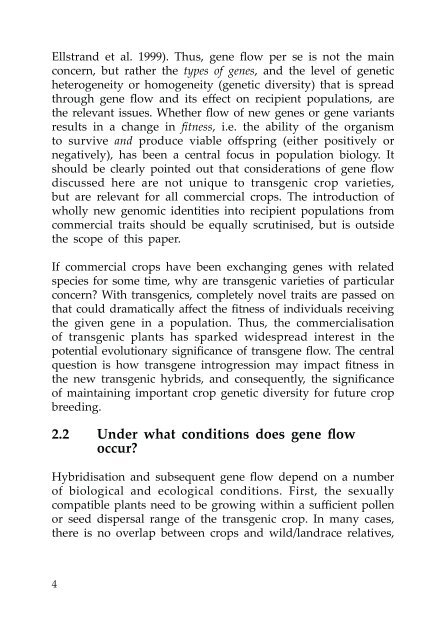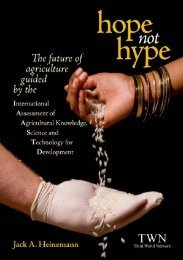gene Flow: Implications for Crop Diversity and Wild Relatives
gene Flow: Implications for Crop Diversity and Wild Relatives
gene Flow: Implications for Crop Diversity and Wild Relatives
- No tags were found...
Create successful ePaper yourself
Turn your PDF publications into a flip-book with our unique Google optimized e-Paper software.
Ellstr<strong>and</strong> et al. 1999). Thus, <strong>gene</strong> flow per se is not the mainconcern, but rather the types of <strong>gene</strong>s, <strong>and</strong> the level of <strong>gene</strong>tichetero<strong>gene</strong>ity or homo<strong>gene</strong>ity (<strong>gene</strong>tic diversity) that is spreadthrough <strong>gene</strong> flow <strong>and</strong> its effect on recipient populations, arethe relevant issues. Whether flow of new <strong>gene</strong>s or <strong>gene</strong> variantsresults in a change in fitness, i.e. the ability of the organismto survive <strong>and</strong> produce viable offspring (either positively ornegatively), has been a central focus in population biology. Itshould be clearly pointed out that considerations of <strong>gene</strong> flowdiscussed here are not unique to transgenic crop varieties,but are relevant <strong>for</strong> all commercial crops. The introduction ofwholly new genomic identities into recipient populations fromcommercial traits should be equally scrutinised, but is outsidethe scope of this paper.If commercial crops have been exchanging <strong>gene</strong>s with relatedspecies <strong>for</strong> some time, why are transgenic varieties of particularconcern? With transgenics, completely novel traits are passed onthat could dramatically affect the fitness of individuals receivingthe given <strong>gene</strong> in a population. Thus, the commercialisationof transgenic plants has sparked widespread interest in thepotential evolutionary significance of trans<strong>gene</strong> flow. The centralquestion is how trans<strong>gene</strong> introgression may impact fitness inthe new transgenic hybrids, <strong>and</strong> consequently, the significanceof maintaining important crop <strong>gene</strong>tic diversity <strong>for</strong> future cropbreeding.2.2 Under what conditions does <strong>gene</strong> flowoccur?Hybridisation <strong>and</strong> subsequent <strong>gene</strong> flow depend on a numberof biological <strong>and</strong> ecological conditions. First, the sexuallycompatible plants need to be growing within a sufficient pollenor seed dispersal range of the transgenic crop. In many cases,there is no overlap between crops <strong>and</strong> wild/l<strong>and</strong>race relatives,4
















